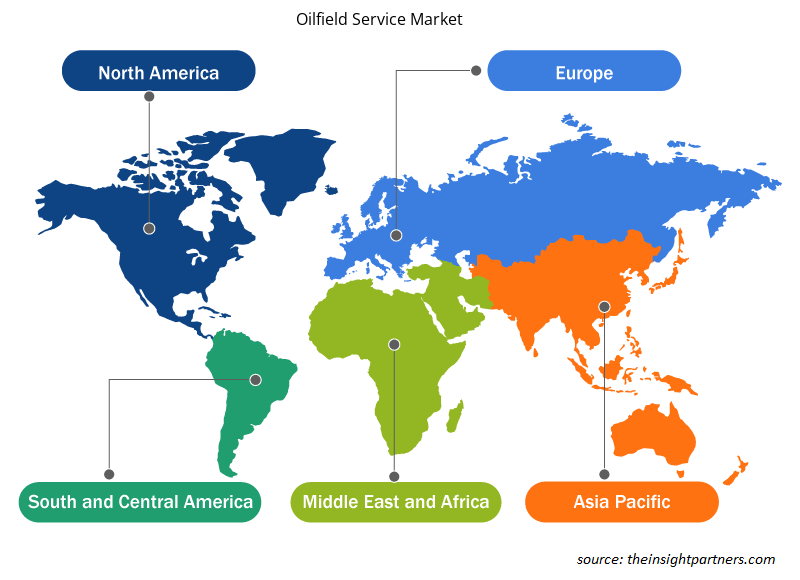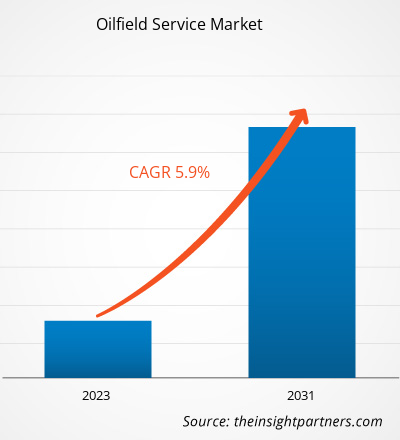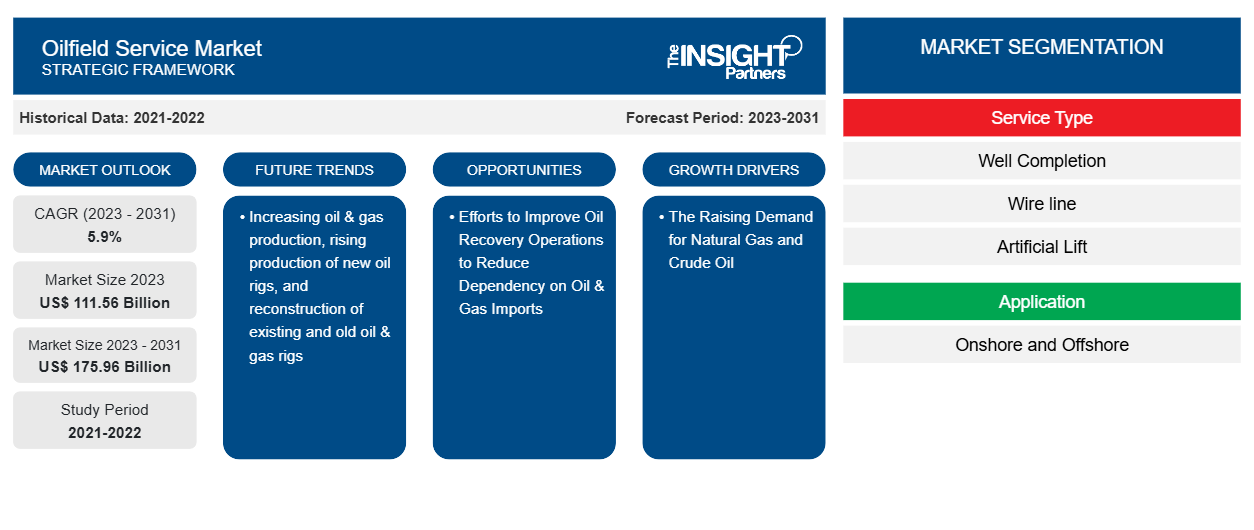من المتوقع أن يصل حجم سوق خدمات حقول النفط إلى 175.96 مليار دولار أمريكي بحلول عام 2031 من 111.56 مليار دولار أمريكي في عام 2023. ومن المتوقع أن يسجل السوق معدل نمو سنوي مركب بنسبة 5.9٪ خلال الفترة 2023-2031. ومن المرجح أن تظل زيادة إنتاج النفط والغاز، وارتفاع إنتاج منصات النفط الجديدة، وإعادة بناء منصات النفط والغاز الحالية والقديمة، من الاتجاهات الرئيسية في السوق.
تحليل سوق خدمات حقول النفط
من المتوقع أن يشهد سوق خدمات حقول النفط نموًا كبيرًا خلال الإطار الزمني الذي تم تحليله نظرًا للعدد المتزايد من مشاريع الغاز الطبيعي بالإضافة إلى اكتشاف حقول نفط جديدة، وخاصة في المواقع النائية. بالإضافة إلى ذلك، أدى استنفاد احتياطيات النفط والغاز الحالية في مختلف البلدان إلى خلق طلب على خطوط الأنابيب عبر الحدود لتوريد المنتجات المرتبطة بالنفط والغاز، مما يعزز نمو سوق خدمات حقول النفط. يعد الطلب المتزايد على طرق النقل الفعالة من حيث التكلفة للنفط والغاز أحد العوامل الرئيسية التي من المتوقع أن تعزز الطلب على خدمات حقول النفط في قطاع النفط والغاز في الخارج في جميع أنحاء العالم.
نظرة عامة على سوق خدمات حقول النفط
مع تزايد عدد السكان والتصنيع، يرتفع الطلب على الطاقة أيضًا على المستوى العالمي. كما أدى ارتفاع استهلاك الطاقة إلى زيادة الحاجة إلى النفط والغاز في الاقتصادات النامية والمتقدمة. وقد أدى هذا إلى زيادة الطلب على خدمات حقول النفط في جميع أنحاء العالم. بالإضافة إلى ذلك، فإن العدد الكبير من السكان وارتفاع دخل الفرد والتصنيع السريع يدفع سوق تجهيزات الأنابيب والفلنجات للنفط والغاز البحري في منطقة آسيا والمحيط الهادئ. تعد المنطقة أكبر مستهلك للنفط الخام والغاز. علاوة على ذلك، أفادت البلدان الصناعية للغاية في منطقة آسيا والمحيط الهادئ، بما في ذلك اليابان والصين والهند وكوريا الجنوبية، بزيادة استهلاك الطاقة بشكل عام. تزيد هذه البلدان من تركيزها على تعزيز إنتاج النفط المحلي من خلال تقنيات مختلفة لاستخراج النفط المعزز، مما يدعم نمو السوق في منطقة آسيا والمحيط الهادئ لتلبية الطلب المتزايد على النفط.
قم بتخصيص هذا التقرير ليناسب متطلباتك
ستحصل على تخصيص لأي تقرير - مجانًا - بما في ذلك أجزاء من هذا التقرير، أو تحليل على مستوى الدولة، وحزمة بيانات Excel، بالإضافة إلى الاستفادة من العروض والخصومات الرائعة للشركات الناشئة والجامعات
-
احصل على أهم اتجاهات السوق الرئيسية لهذا التقرير.ستتضمن هذه العينة المجانية تحليلاً للبيانات، بدءًا من اتجاهات السوق وحتى التقديرات والتوقعات.
محركات وفرص سوق خدمات حقول النفط
ارتفاع الطلب على الغاز الطبيعي والنفط الخام يصب في صالح السوق
يشهد الطلب على النفط والغاز الطبيعي زيادة مستمرة في جميع أنحاء العالم. وقد سجلت الولايات المتحدة والصين أكبر نمو. وأدى الارتفاع القوي في الطلب على البتروكيماويات في الولايات المتحدة إلى زيادة الاستهلاك. كما أن الارتفاع في الإنتاج الصناعي، إلى جانب الطلب المرتفع على خدمات النقل بالشاحنات، يعزز الطلب على البتروكيماويات ، وبالتالي يغذي نمو سوق خدمات حقول النفط. وعلاوة على ذلك، فإن النمو في أحجام الحركة الجوية في جميع أنحاء العالم، وخاصة في الاقتصادات النامية في آسيا، هو عامل مهم آخر يؤدي إلى زيادة استهلاك النفط.
جهود تحسين عمليات استخراج النفط لتقليل الاعتماد على واردات النفط والغاز
لقد تم استغلال طريقة حقن البخار تجارياً على مدى العقود الأخيرة لتحسين عملية الاستخراج من خزانات النفط الثقيل التقليدية في مراحلها الأخيرة من التطوير. يعمل البخار المحقون على زيادة الضغط الكلي لخزان النفط البحري، مما يساعد على تحسين نسبة تنقل النفط الخام ويسمح له بالتدفق بكفاءة. ونتيجة لذلك، تساعد طرق استخراج النفط المحسنة في تنشيط عمليات الاستخراج في آبار النفط البحرية الحالية. تستثمر بلدان مختلفة في الجهود المبذولة لتجديد مواردها النفطية الحالية لتعزيز إنتاج النفط المحلي وتقليل اعتمادها على واردات النفط. وبالتالي، من المتوقع أن يوفر التوسع المتوقع لعمليات النفط والغاز فرص نمو واعدة للاعبين في سوق خدمات حقول النفط في السنوات القادمة.
تقرير تحليل تجزئة سوق خدمات حقول النفط
إن القطاعات الرئيسية التي ساهمت في استخلاص تحليل سوق خدمات حقول النفط هي نوع الخدمة والتطبيق.
- بناءً على نوع الخدمة، ينقسم سوق خدمات حقول النفط إلى استكمال الآبار، والخطوط السلكية، والرفع الاصطناعي، والتثقيب، وسوائل الحفر والاستكمال، وغيرها. احتلت شريحة الخدمات الأخرى أكبر حصة في سوق خدمات حقول النفط في عام 2023.
- بحسب نوع المادة، يتم تقسيم السوق إلى خدمات حقول النفط البرية والبحرية. وقد استحوذ قطاع خدمات حقول النفط البرية على الحصة الأكبر في سوق خدمات حقول النفط في عام 2023.
تحليل حصة سوق خدمات حقول النفط حسب المنطقة الجغرافية
ينقسم النطاق الجغرافي لتقرير سوق خدمات حقول النفط بشكل أساسي إلى خمس مناطق: أمريكا الشمالية، وآسيا والمحيط الهادئ، وأوروبا، والشرق الأوسط وأفريقيا، وأمريكا الجنوبية والوسطى.
تنقسم سوق خدمات حقول النفط في أمريكا الشمالية إلى الولايات المتحدة وكندا والمكسيك. تهيمن المنطقة على سوق خدمات حقول النفط العالمية بسبب مشاريع التنقيب عن النفط والغاز وإنتاجهما على نطاق واسع وزيادة الأنشطة الجديدة في الولايات المتحدة وخليج المكسيك وكندا. كان هناك 912.962 بئر نفط وغاز في الولايات المتحدة في ذلك العام. تساهم الزيادة في عدد الآبار الأفقية في الولايات المتحدة وارتفاع إنتاج النفط والغاز الصخري لكل منصة في نمو سوق خدمات حقول النفط في البلاد. إن ظهور أنظمة خدمات حقول النفط الذكية المتقدمة، مثل أنظمة استكمال التحكم في التدفق الذاتي التكيفي عالية الجودة، من شأنه أن يدفع نمو السوق في أمريكا الشمالية في السنوات القادمة. إن الطلب المرتفع على المعدات البرية بسبب الآفاق الكبيرة في حوض بيرميان وداكوتا الشمالية، وخاصة في عدد كبير بشكل متزايد من المشاريع غير التقليدية، من شأنه أن يزدهر نمو سوق خدمات حقول النفط للقطاع البري.
رؤى إقليمية حول سوق خدمات حقول النفط
لقد قام المحللون في Insight Partners بشرح الاتجاهات والعوامل الإقليمية المؤثرة على سوق خدمات حقول النفط طوال فترة التوقعات بشكل شامل. يناقش هذا القسم أيضًا قطاعات سوق خدمات حقول النفط والجغرافيا في جميع أنحاء أمريكا الشمالية وأوروبا ومنطقة آسيا والمحيط الهادئ والشرق الأوسط وأفريقيا وأمريكا الجنوبية والوسطى.

- احصل على البيانات الإقليمية المحددة لسوق خدمات حقول النفط
نطاق تقرير سوق خدمات حقول النفط
| سمة التقرير | تفاصيل |
|---|---|
| حجم السوق في عام 2023 | 111.56 مليار دولار أمريكي |
| حجم السوق بحلول عام 2031 | 175.96 مليار دولار أمريكي |
| معدل النمو السنوي المركب العالمي (2023 - 2031) | 5.9% |
| البيانات التاريخية | 2021-2022 |
| فترة التنبؤ | 2023-2031 |
| القطاعات المغطاة |
حسب نوع الخدمة
|
| المناطق والدول المغطاة |
أمريكا الشمالية
|
| قادة السوق وملفات تعريف الشركات الرئيسية |
|
كثافة اللاعبين في السوق: فهم تأثيرها على ديناميكيات الأعمال
يشهد سوق خدمات حقول النفط نموًا سريعًا، مدفوعًا بالطلب المتزايد من المستخدم النهائي بسبب عوامل مثل تفضيلات المستهلكين المتطورة والتقدم التكنولوجي والوعي المتزايد بفوائد المنتج. ومع ارتفاع الطلب، تعمل الشركات على توسيع عروضها والابتكار لتلبية احتياجات المستهلكين والاستفادة من الاتجاهات الناشئة، مما يؤدي إلى زيادة نمو السوق.
تشير كثافة اللاعبين في السوق إلى توزيع الشركات أو المؤسسات العاملة في سوق أو صناعة معينة. وهي تشير إلى عدد المنافسين (اللاعبين في السوق) الموجودين في مساحة سوق معينة نسبة إلى حجمها أو قيمتها السوقية الإجمالية.
الشركات الرئيسية العاملة في سوق خدمات حقول النفط هي:
- شركة شلمبرجير المحدودة
- ويذرفورد انترناشيونال بي ال سي
- شركة بيكر هيوز
- شركة هاليبرتون
- شركة ناشونال أويلويل فاركو المحدودة
- تكنيب اف ام سي
إخلاء المسؤولية : الشركات المذكورة أعلاه ليست مرتبة بأي ترتيب معين.

- احصل على نظرة عامة على أهم اللاعبين الرئيسيين في سوق خدمات حقول النفط
أخبار سوق خدمات حقول النفط والتطورات الأخيرة
يتم تقييم سوق خدمات حقول النفط من خلال جمع البيانات النوعية والكمية بعد البحث الأولي والثانوي، والتي تتضمن منشورات الشركات المهمة وبيانات الجمعيات وقواعد البيانات. فيما يلي بعض التطورات في سوق خدمات حقول النفط:
- أعلنت شركة بيكر هيوز عن توسيع أعمال خدمات ومعدات حقول النفط في غيانا. وتستعد شركة بيكر هيوز لتطوير منشأة مركزية عملاقة جديدة في غيانا لخدمات ومعدات حقول النفط. (المصدر: بيكر هيوز، بيان صحفي، فبراير 2022)
- أعلنت شركة شلمبرجير المحدودة عن إطلاق خدمة رسم الخرائط متعددة الطبقات أثناء الحفر Periscope Edge. توفر الخدمة قياسات جديدة وعملية عكس رائدة في الصناعة جنبًا إلى جنب مع حلول سحابية لتوفير توجيه جغرافي دقيق في الخزانات أثناء الحفر. (المصدر: شركة شلمبرجير المحدودة، بيان صحفي، أغسطس 2021)
تقرير سوق خدمات حقول النفط: التغطية والنتائج المتوقعة
يوفر تقرير "حجم سوق خدمات حقول النفط والتوقعات (2021-2031)" تحليلاً مفصلاً للسوق يغطي المجالات التالية:
- حجم سوق خدمات حقول النفط وتوقعاته على المستويات العالمية والإقليمية والوطنية لجميع قطاعات السوق الرئيسية التي يغطيها النطاق
- اتجاهات سوق خدمات حقول النفط بالإضافة إلى ديناميكيات السوق مثل المحركات والقيود والفرص الرئيسية
- تحليل مفصل لـ PEST و SWOT
- تحليل سوق خدمات حقول النفط الذي يغطي اتجاهات السوق الرئيسية والإطار العالمي والإقليمي واللاعبين الرئيسيين واللوائح والتطورات الأخيرة في السوق
- تحليل المشهد الصناعي والمنافسة الذي يغطي تركيز السوق، وتحليل خريطة الحرارة، واللاعبين البارزين، والتطورات الأخيرة لسوق خدمات حقول النفط
- ملفات تعريف الشركة التفصيلية
- التحليل التاريخي (سنتان)، سنة الأساس، التوقعات (7 سنوات) مع معدل النمو السنوي المركب
- تحليل PEST و SWOT
- حجم السوق والقيمة / الحجم - عالمي، إقليمي، بلد
- الصناعة والمنافسة
- مجموعة بيانات إكسل
التقارير الحديثة
شهادات العملاء
سبب الشراء
- اتخاذ قرارات مدروسة
- فهم ديناميكيات السوق
- تحليل المنافسة
- رؤى العملاء
- توقعات السوق
- تخفيف المخاطر
- التخطيط الاستراتيجي
- مبررات الاستثمار
- تحديد الأسواق الناشئة
- تحسين استراتيجيات التسويق
- تعزيز الكفاءة التشغيلية
- مواكبة التوجهات التنظيمية























 احصل على عينة مجانية ل - سوق خدمات حقول النفط
احصل على عينة مجانية ل - سوق خدمات حقول النفط